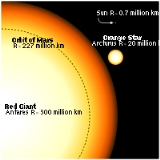
Red supergiant
Overview
Supergiant
Supergiants are among the most massive stars. They occupy the top region of the Hertzsprung-Russell diagram. In the Yerkes spectral classification, supergiants are class Ia or Ib . They typically have bolometric absolute magnitudes between -5 and -12...
star
Star
A star is a massive, luminous sphere of plasma held together by gravity. At the end of its lifetime, a star can also contain a proportion of degenerate matter. The nearest star to Earth is the Sun, which is the source of most of the energy on Earth...
s (luminosity class I) of spectral type K or M. They are the largest stars in the universe in terms of volume
Volume
Volume is the quantity of three-dimensional space enclosed by some closed boundary, for example, the space that a substance or shape occupies or contains....
, although they are not the most mass
Mass
Mass can be defined as a quantitive measure of the resistance an object has to change in its velocity.In physics, mass commonly refers to any of the following three properties of matter, which have been shown experimentally to be equivalent:...
ive. Betelgeuse
Betelgeuse
Betelgeuse, also known by its Bayer designation Alpha Orionis , is the eighth brightest star in the night sky and second brightest star in the constellation of Orion, outshining its neighbour Rigel only rarely...
and Antares
Antares
Antares is a red supergiant star in the Milky Way galaxy and the sixteenth brightest star in the nighttime sky . Along with Aldebaran, Spica, and Regulus it is one of the four brightest stars near the ecliptic...
are the best known examples of a red supergiant.
After the hydrogen in a star's core has fused, stars with more than about 10 solar mass
Solar mass
The solar mass , , is a standard unit of mass in astronomy, used to indicate the masses of other stars and galaxies...
es become red supergiants for the duration of their helium-burning phase.
Unanswered Questions

